A few days ago, my brother Jack informed me that he was going to prepare some sort of book for his grandchildren about his own childhood pets, and he asked me for my recollections about our family pets. I put the following together and thought it was worth sharing.
CROWS
Edgar Allen Crow
I believe it was in the 5th grade when Perry Ann Owen’s father gave me my first baby crow, probably about April. My recollection is that Perry Ann’s father worked for the electric company and had the ability to climb poles and maybe trees. Whether the crow came from a pole or a tree, I don’t know. Why he obtained the crow, I don’t remember.
In any event, we ended up with a very young and hungry baby crow. Someone built us a “crow cage” in the back yard, sort of a large doghouse with hardware cloth (wire mesh) sides and an asphalt shingle roof, where the crow initially resided.
We fed the crow a mixture of canned dog food and oatmeal or cornmeal mixed up with water in a plastic catsup squeeze bottle. When the crow was hungry, we just stuck the spout of the bottle down the crow’s goozle and gave him/her helping after helping until he/she was filled.
We named the crow “Edgar Allen Crow,” Edgar for short, gender unknown, so I will refer to him/her as “him” from now on.
As Edgar grew and fledged out, we ceased to confine him to the cage, as he seemed to want to hang around and had no desire to desert his food source. As I recall, his diet eventually became solely canned dog food plus whatever else he could scavenge in the neighborhood.
Whenever it was time to feed him, or whenever I just wanted him around, I would loudly call “Here Edgar,” and he would come flying in from wherever he was, sometimes blocks away.
Edgar was very friendly and seemed to crave human company. Our family often convened on the patio along with other kids and friends of my parents. Edgar was a trickster, as crows are known to be. In those days, most men smoked, and they typically carried a cigarette pack in their shirt pockets. Edgar loved to perch on a man’s shoulder, then pluck the entire cigarette pack from his pocket, fly up into a tree and shred the cigarettes one by one. Way ahead of his time, it seems.
I remember one time a friend of my parents’ tempted Edgar with his car keys, jangling them enticingly. Edgar plucked the car keys, flew to the top of a nearby oak tree and hung them on a limb about 50 feet up, then crow-laughed loudly. They keys may be still there if the tree is still alive.
Edgar had an amazing vocabulary of sounds that he practiced constantly. There was an old myth that a crow could talk if you split his tongue, which just that – a myth. We never split Edgar’s tongue, but Edgar could mimic human sounds, like “hello.”
I remember that Edgar would sit atop my dog Spot and they would roam around looking for cats to chase. Spot would chase a cat up a tree, then Edgar would attack it in the tree, forcing it down again. I don’t think they ever did any damage, but they had the neighborhood cats on edge.
One time, Edgar was sitting outside the window of a neighbor’s bathroom practicing his human sounds. He so upset the woman in the bathroom that she called the cops!
Another of Edgar’s favorite pastimes was to perch on top the backstop at the Little League field at the nearby city park, practicing his vocabulary and annoying both pitcher and batter.
Interacting with Edgar was a daily occurrence all summer and into the fall when he began to come around less and less until finally he was gone. I figured he went off with the wild crows when mating season started. He didn’t just leave all at once. He would be gone a day, then come back. Then leave again and stay away two or three days and then return. The absences stretched out until he was gone for good. I used to think I could hear him whenever a flock (I think the official name is “murder”) of crows came into the neighborhood. I would call and call, but, alas, Edgar had flown the coop.
Loki and Satan
The next spring, Perry Ann’s father brought me two crows, which we named Loki and Satan.
Being an experienced crow hand by then, I simply repeated what had been successful with Edgar. My recollections of Loki and Satan are not as vivid as those of Edgar perhaps because the novelty had worn off. I simply remember that they were great fun to have around, and their antics were similar to those of Edgar.
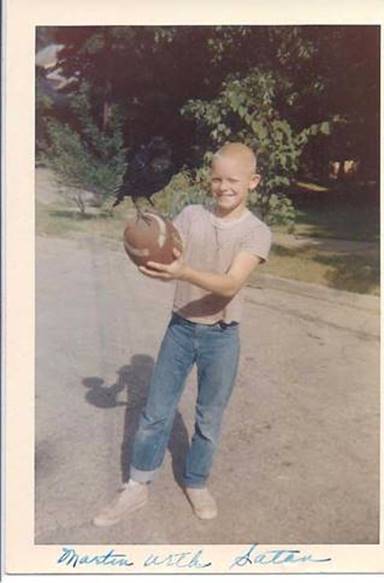
“Martin with Satan” probably about 1956
Like Edgar, Loki and Satan eventually flew away in the fall, I hope to start a crow family dynasty of their own somewhere. Perhaps their descendants are still wild and free in northwest Arkansas.
After the two crow years, the crow cage remained in our backyard as long as I can remember, and we became the depository for any abandoned or injured animal, with the crow cage being its temporary home. We had birds, including a small raptor and other small animals.
DOGS
Tippy
I recall that our first dog was a brown puppy named “Tippy,” I think because he had a white tip on the end of his tail. I think we acquired him when I was about in the first grade, soon after we moved to 26 West Davidson Street. All I remember about Tippy is that he contracted some sort of malady and died in short order. Very sad.
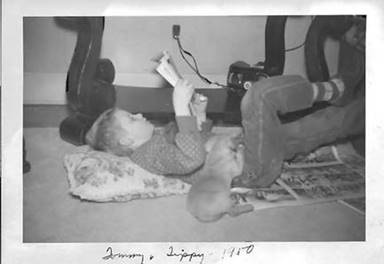
“Tommy and Tippy, 1950”
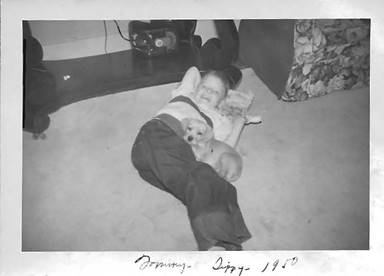
“Tommy and Tippy, 1950”
Spot
The next dog was the legendary “Spot,” probably named after “Spot” in our first grade readers about Dick and Jane. To this day, I remember the iconic passage from the reader, “See Spot run!”
Spot was a pointer bird dog, I think maybe a gift from Ogden Shirley, who was a friend of my parents and a breeder of fine bird dogs. Quail hunting was both popular and successful in those days when there were still fields of harvested corn around northwest Arkansas.
My best guess is that we acquired Spot about 1951 when I would have been seven years old. Spot was the quintessential “family dog” for her 13-14- year life. She was my constant companion, following me to Washington elementary school, a couple of blocks away, every day.
Spot was allowed in the house, but she never spent the night indoors. She had a doghouse in the backyard on the edge of the “woods.” It had a chicken wire fence around it that, as I recall, wasn’t particularly successful in containing her.
She had a circle of admirers in the neighborhood who regularly fed her. In those days, dogs roamed free, although I recall she was picked up by the dogcatcher once. I was so angry, I called the mayor and cussed him out, Then my dad whipped me.
I think Spot must have been spayed because I don’t remember any puppies, but there may have been some.
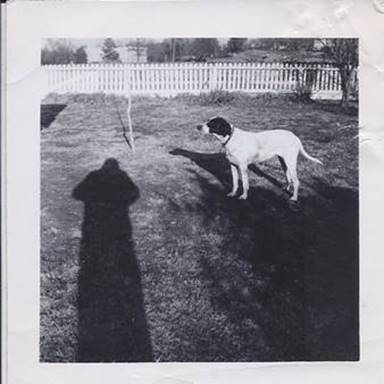
Spot at my grandparents’ home in Batesville
For us, Spot was a pet, but my dad did his best to train Spot as a quail hunter, and as I recall, she was a pretty good bird dog. I hunted a lot with my dad, and later with friends when we were in high school. Spot was always with us.
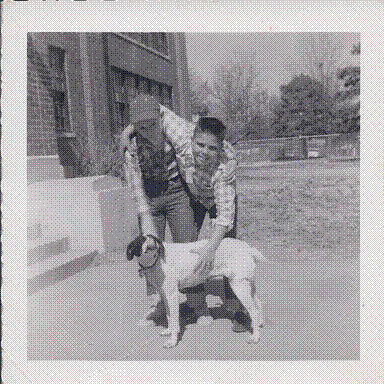
Spot at Washington School with Joey Cavendar and me
My favorite story about Spot was her adoption of “Cluck-Cluck.” In those days, trucks from the rural chicken farms brought chickens into the Tyson’s processing plant in Fayetteville near the old Fayetteville Junior High on the northwest corner of West Meadow and North West Avenue. The trucks were flatbeds with wooden chicken crates stacked atop them. Being wood, some of the crates would break open occasionally, and the chickens would escape. North College, then the main Highway 71 through Fayetteville, was three blocks west of our house at 26 West Davidson and well within Spot’s normal roaming range.
One day, Spot brought home a bedraggled chicken that had escaped from a passing chicken truck. We knew it came from a truck because its beak had been clipped (debeaking) , a practice that kept chickens from pecking each other to death. The tail feathers were gone, and it was a sorry looking bird. But bird dogs have “soft mouths,” and the chicken was otherwise uninjured.
Spot had a habit of bringing all kinds of things home that she acquired in her neighborhood rounds. Once she brought home a really fine butcher knife, which my mother promptly incorporated into her kitchen utensil collection.
Spot took the chicken, which we named “Cluck-Cluck” into her doghouse, where it resided, eating dog food kibbles alongside Spot and drinking from her water bowl. It followed her everywhere. She eventually started laying eggs in the doghouse, which we collected daily. Her tail feathers grew back in, and she became a handsome chicken.
After several months, Cluck-Cluck suddenly disappeared. We looked everywhere, but no Cluck-Cluck. We figured maybe a stray dog has killed her.
Then one day, my mom was cleaning up the patio, when she turned over a large soup kettle that had been lying upended there for days. Under it was Cluck-Cluck, seemingly near death and sitting on a large pile of chicken shit. Her little comb was all wilted. Cluck-Cluck staggered over to the hose bibb where Spot’s water bowl was kept filled, and she drank and drank. Finally her little comb perked back up, and she looked as good as new. We all rejoiced, including Spot.
Alas, several weeks later, Cluck-Cluck disappeared again for good, probably victim to some neighborhood dog.
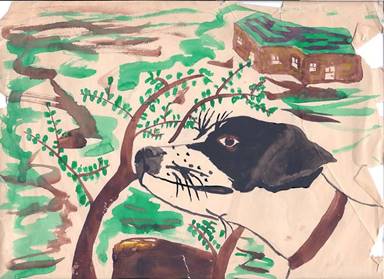
Watercolor of Spot by Tom Butt
Spot died I believe in the summer of 1965 when I was working in Yellowstone National Park. My parents told me she had been hit by a car up on Forrest Avenue. She would have been about 14 years old.
CATS
Cats didn’t leave much of an impression on me. Based on the photo below, we had a cat named “Frizzie” when we live on Conner Street in 1948, when I would have been 4 years old.
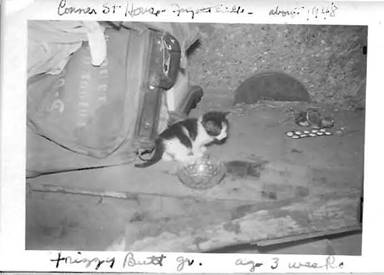
“Frizzie Butt, age 3 weeks, Conner Street House, Fayetteville, about 1948”
After we moved to Davidson Street, the only cat I can remember was named “Blackjack.” In fact, I think we had a succession of cats all named Blackjack. I remember at least one litter of kittens from one of the Blackjacks. Our cats were outdoor animals, except I think they were allowed in the basement in the winter.
RABBIT
The only rabbit I remember was a wild cottontail that had been abandoned (at least that’s what we concluded) by its mother. I took it home and fed it milk with an eye dropper. I kept it in a box in my bedroom. Despite warning by my parents to the contrary, I slept with the little bunny at night in my bed. Unfortunately, I rolled over on it one night and suffocated it, proving my parents right. It was very sad.
TURTLES
The common turtle in the Arkansas Ozarks is the Three-toed Box Turtle (Terrapene carolina triunguis). Off and on for several years,I acquired quite a few of these and kept them in an enclosure in the yard, at one time, my neighbor, Charles White, was a fellow “turtle farmer.” Turtles are omnivores and eat about anything, but what I most remember feeding them is lettuce, tomatoes and strawberries. I’m not sure what the fascination was, but turtles are pretty mellow pets.
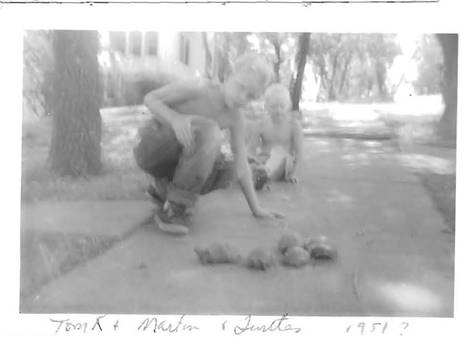
“Tom K. and Martin and turtles, 1951”
I remember one time my parents drove me up to Aurora, Missouri, where I could board the Missouri Pacific passenger train to Batesville, Arkansas, to visit my grandparents. My indulgent parents ( an Missouri Pacific) allowed me to bring along a basket full of pet turtles. It caused quite a fuss when they all escaped, and the conductor and other passengers combed the coaches corralling stray turtles.
I was reminded of the great turtle escape many years later when Andrew and Daniel brought a jar full of fireflies (lightning bugs) home with them in an airplane after visiting Arkansas. It was night and the plane was dark. They let them loose on the plane where they caused quite a sensation.
WASPS
At some point when I was in elementary school, I developed a fascination with wasps, paper wasps, to be exact, members of the vespid subfamily Polistinae. Wasps were common in those days, typically building nests under roof overhangs. I somehow discovered that these wasps would only attack when they detected movement. I started a small service business removing wasp nests for people when they got too close to doors or other occupied areas. I found that I could knock the nest down with some kind of pole, and if I stood stock still until things calmed down, I would never get stung. Then I went from simply removing nests to collecting them. I built a small portable cage of hardware cloth (wire mesh), and placed nests in it.
When the larvae matured and hatched into wasps, they would continue to hang around the their birthplace, and they instinctively tended the nest. I researched what they ate and kept them fed. So I always had a cage full of nests and wasps. Then, I discovered that I could hold a wasp with tweezers and clip off a small bit of the end of its stinger without otherwise harming it. Unlike honey bees, which die once they have deployed their stingers, wasps can sting multiple times. Once the wasp stingers were rendered ineffective, I could carry them around in my hands, striking terror into anyone I approached, especially girls.
I carried this fascination for insects even into high school, where everyone in biology class was required to create and turn in an insect collection with some number of orders and species represented. I turned it into a business, creating and selling ready-made insect collections to my classmates. I had always been a pretty good model builder, and when just collecting insects got boring, I branched out and used my model making skills to create new and heretofore unknown insects made from parts of several insects, thus creating and naming my own species. When the teacher figured this out, there was hell to pay. |

